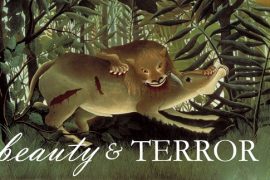We humans like to think we are creatures superior to all other aspects of Nature. Other than beavers, we are the only creatures that can manipulate and change entire ecosystems. We take this term dominion (Genesis 1:26 and 1:28) from the King James Version:
Then God said, ‘Let Us make man in Our image, according to Our likeness; let them have dominion over the fish of the sea, over the birds of the air, and over the cattle, over all[ref]In Syriac it reads “all the animals of”[/ref] the earth and over every creeping thing that creeps on the earth.’ And God blessed them, and God said unto them, ‘Be fruitful, and multiply, and replenish the earth, and subdue it: and have dominion over the fish of the sea, and over the fowl of the air, and over every living thing that moveth upon the earth.’
And I think we take it a little too seriously. What do I mean? A couple of examples will illustrate this point. We think we can “improve” on Nature by altering the genetics of various plants and animals at will. We blow the tops of mountains to get at coal and then “create” better habitat for wildlife and livestock. Go into any city in this nation and drive through looking at the same big box stores, the same strip malls, the same fast food restaurants, and the same subdivisions that appear devoid of life and culture. Finally, look at how we use plants in the landscape—they’re pretty much all the same.
Exotic plants are harming native plants, animals, and ecosystems with tremendous costs, economically and ecologically, to the great diversity of this planet and the many unique life forms that inhabit it.
With tremendous costs, economically and ecologically, to the great diversity of this planet and the many unique life forms that inhabit
We should start with a few definitions and disclaimers. First the definitions. Exotic means introduced from another location where the organism would not normally occur. Native means the organism occurs in a particular habitat and in the case of plants, it is adapted to the soils, climate, weather, terrain, and other unique aspects that allow it to flourish. Invasive means the organism has the ability to escape into natural habitats and cause a variety of problems, which will be discussed later. An invasive exotic, is an introduced species (either accidentally or purposely) that has escaped into the environment and persists and flourishes without any assistance from man.
Now for the disclaimers. We rely on exotic plants and animals for our nourishment, such as corn, soybeans, wheat, tomatoes, and a whole host of other plants that feed us. Same with animals like beef, chicken, sheep and goats. Furthermore, not all introduced exotic organisms become invasive.
However, that said, Reichard and White (1997) indicated that 85% of 235 invasive species of woody plants were used for landscaping or erosion control. The Nature Conservancy reported that six non-governmental agencies reported between 34% and 85% of the total number of invasive species in the United States had a horticultural origin. Finally the California Invasive Plant Council inventory showed about 37% of invasive plants were accidentally introduced as contaminants in seed, clothing, equipment, vehicles, ballast, animals, or packing materials. The remaining 63% were purposely introduced for landscape purpose, pond or indoor ornamentals, aquarium plants, soil stabilization species, animal forage or human food and medicinal plants. They emphasized, “The majority of these intentionally introduced plant species came through the nursery industry as ornamental landscape species.”
The next question you might ask is “Why, what is the problem with moving plants all over the world?” First and foremost, from a religious standpoint, is who do we think we are? We are playing God with his creation and it is extremely arrogant to think we know better than the almighty creator. This great diversity was given to us to appreciate. In the first chapter of Genesis, God sees creation as good multiple times! What makes us think we can do better than God?
They’re wreaking havoc
From a practical, ecological, and economic standpoint, these species are wreaking havoc in natural ecosystems. Invasive plants are second only to habitat loss in endangering native plants, and 57% of imperiled species were impacted by non-native species (Wilcove et al. 1998). Furthermore, it is now widely established in the scientific literature that invasive plants result in increased competition for resources, hybridize with natives, change hydrological cycles, increase nitrogen fixation, increase the frequency or alter the natural disturbance cycles and increase sedimentation, decrease species diversity and lead to global and local homogenization of the flora. This is just a short list of the problems caused by these species.
The most widely accepted estimate for what invasive organisms cost the United States is about $148 billion a year overall. Here are some details from this figure: weeds account for $306 billion annually, aquatic weeds cost us $122 million, purple loosestrife (one of those excellent horticultural plants) costs us $50 million a year, and in Portland, Oregon, it cost $31 million to control invasive plants on 40% of all public lands.
What you can do
- Become educated about the problem and what species are problematic in your area. This information is often available at the national level with the Department of Agriculture’s Library and the National Invasive Species Information Center. Locally, many states have an exotic pest plant council, and many natural resource agencies can also provide that information.
- Begin at home and do an inventory of the exotic invasive plants in your landscape and seek to remove them and replace them with suitable natives. Once this has been accomplished, do the same for your church grounds.
- Be a responsible plant purchaser and ask the local nursery to carry more natives; and if they carry exotic invasives, then ask them to discontinue their use. If they do not agree to this, then stop patronizing that business.
- Work to establish an early detection and rapid response team to find and eradicate new exotic species. Research shows this is the only way to get ahead of the ballgame, by eliminating them when they are first seen and then being vigilant to find and remove species as they are reported.
- Spread the word about the problem and support conservation organizations that actively work to control invasive species. Most of these items are not that difficult to accomplish and require just a bit of good old fashioned work. But it all begins at home and it spreads from there.
I hope and pray that the future will hold the opportunity for future generations to see all the wonderful places and creatures that fill God’s Creation. For the psalmist said, “The earth is the Lord’s; and everything that is in it.” [ref] Psalms 24:1 [/ref]





